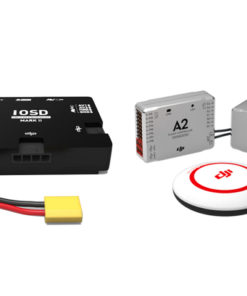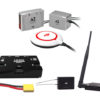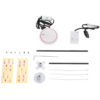A2
Advanced Stabilization Controller
The extraordinary precision of the A2 sets a new standard in flight control by providing a complete, stable flight system for a wide variety of multi-rotor platforms.
“9 Multi-Rotor Configurations & Customized Motor Mixer”
“The A2 was designed for commercial and industrial multi-rotor platforms. Simple configuration, easy installation, and stable performance make it perfect for almost any application. The A2 also supports customized motor mixing, which allows it to meet the specific demands of individual users.
The A2 supports nine different motor configurations: Quad I / Quad X / Hex I / Hex V / Hex IY / Oct X / Oct I / Oct V”
Intelligent Orientation Control (IOC)
“Usually, the forward flight direction corresponds with the aircraft’s nose direction. Intelligent Orientation Control (IOC) allows the forward direction to be set to any specified direction, regardless of how the nose orientation changes during flight.
In Course Lock flying, the forward flight direction is set to correspond with nose direction of the aircraft at the time that Course Lock mode is activated. In Home Lock flying, the forward flight direction is the same as the direction from Home Point to the aircraft.”
Point of Interest (POI)
Users can record the position of the aircraft as a Point of Interest, at any time, using a switch on the remote controller. Then, when the left control stick is pushed either left or right, the aircraft can perform a circular flight around the Point of Interest, with its nose pointing toward the POI. This distance from the aircraft to the POI can be set between 16 feet (5 meters) and 1,640 feet (500 meters). This function is easy to set up and simple to operate, making it the ideal solution for when you want to fly 360 degrees around a specific point at a fixed distance.
Intelligent Landing Gear
Once the Intelligent Landing Gear function has been enabled in the Assistant software, the landing gear will be lowered whenever the aircraft is close to the ground. The system will automatically lower the landing gear in the case of an emergency, motor failure, or auto landing event. This serves to protect the aircraft and the gimbal. You can use the switch to manually change the position of the landing gear when the aircraft reaches an altitude of 16 feet (5 meters) or greater.
Auto Return-to-Home
“If the connection between the aircraft and the controller is broken during flight, and the aircraft’s GPS signal is strong enough, the aircraft will return to the Home Point and land automatically.
You can also press the Return-to-Home button to manually activate this feature at any time.”
“Banked Turn” Mode
In this mode, the roll and yaw control sticks are combined in order to help you perform banked turns using one hand. The aircraft can be maneuvered like a fixed-wing aircraft, thereby providing a new flight experience. Normal and FPV aerial photography are stable and smooth, giving your work a whole new visual effect.
Cruise Control
Activate Cruise Control to lock your aircraft into its current horizontal speed. While cruise control is active, the speed can be adjusted at any time using the remote controller. By maintaining a steady flight speed, you can dedicate more attention to controlling the camera and capture the perfect shot every time. This function also increases the total flight time by eliminating unnecessary speed changes that increase power consumption.
iOSD Mark II
The DJI iOSD MARK II On Screen Display is specially designed for autopilot system during the FPV flight or other aero-modeling activates. The DJI iOSD can transmit video and iOSD information in real time, which will help you to obtain the aircraft status information during a FPV flight. It can display power voltage, flight velocity, height, distance from the home point, horizontal attitude, GPS satellite number, etc. iOSD and video information are superposed on the receiver, making iOSD data clearly visible and bringing you a more involved flight experience.
The DJI iOSD should be used in conjunction with a DJI autopilot system. It supports two video input sources under PAL or NTSC mode, which can be selected remotely by an R/C transmitter switch. The R/C TX switch can also change the wireless video transmitter channel remotely when user uses the wireless video transmitter specified by DJI. The iOSD supports online upgrades. The iOSD has built-in BEC, which is on one hand for the power supply of the camera, on the other hand for the power supply of the autopilot system’s main controller to improve the power supply reliability of the main controller.
Be the first to review “DJI A2 + iOSD Mark II” Cancel reply
Related products
DJI Accessories
DJI Accessories
DJI Accessories
DJI Accessories
DJI Accessories
DJI Accessories
DJI Accessories
DJI Accessories













Reviews
There are no reviews yet.